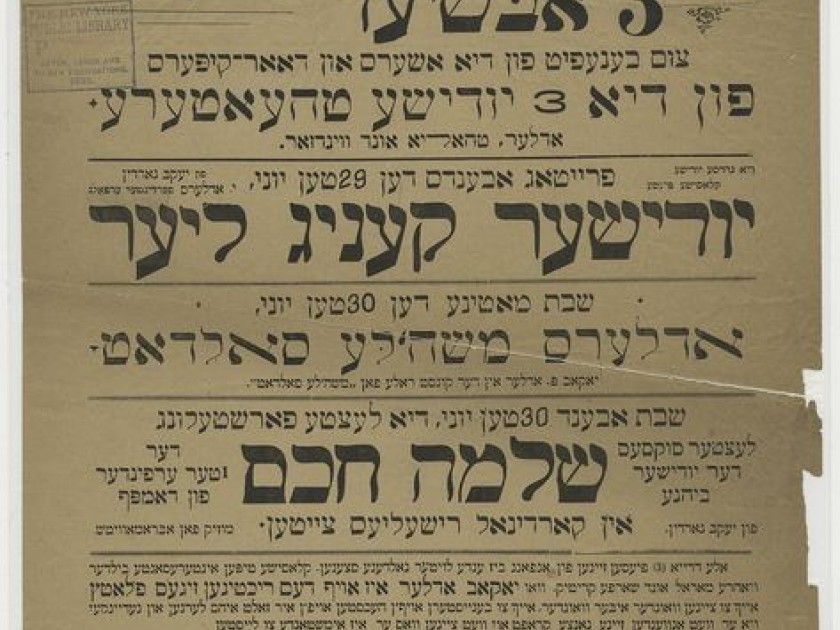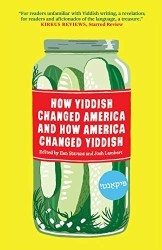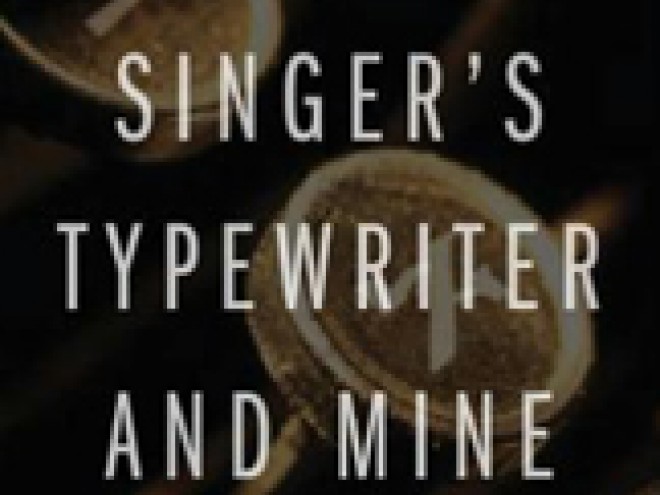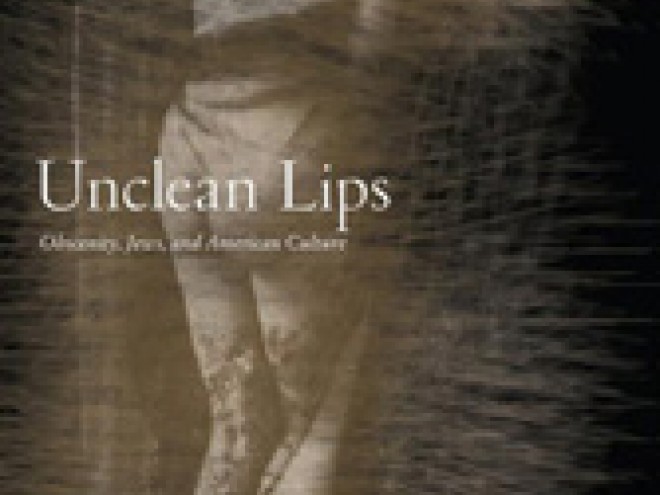
Yiddish poster advertising King Lear, circa 1898.
Seventy-five years after the Holocaust, Yiddish shows extraordinary resilience. Aside from its daily use by the ultra-Orthodox community worldwide, college courses, music and literary festivals, movies and publications, the hit Broadway version of Fiddler on the Roof, and an agricultural movement with Yiddish as its mission are all proof of its strength. Ilan Stavans, Lewis-Sebring Professor of Humanities, Latin American and Latino Culture at Amherst College, and Josh Lambert, Academic Director of the Yiddish Book Center in Amherst, Massachusetts, a nonprofit organization working to recover, celebrate, and regenerate Yiddish and modern Jewish literature and culture, which in 2020 celebrates its 40th anniversary, worked together to curate an anthology celebrating its rich history. The result, How Yiddish Changed America and How America Changed Yiddish, has just been published by Restless Books. Paper Brigade invited them to discuss the anthology and their own relationships with Yiddish.
Ilan Stavans: Yiddish has performed a miraculous reversal. Seventy-five years after the Holocaust, its renewed vitality is something to behold.
Josh Lambert: I agree that Yiddish is having a powerful moment right now: it’s wonderful, for one thing, that during the time we worked on this book, there was a Yiddish-language production of Fiddler on the Roof winning rave reviews on Broadway. But what’s funny is that despite everything we can say about the tragic loss of Yiddish speakers in the 20th century in Europe, and the rejection of the language by many people here in America, Yiddish was astonishingly vital in the U.S. throughout the 20th century. It was just vital in different ways, and always changing — you just have to know where to look. That was certainly something I felt as we started combing through the back issues of Pakn Treger—the magazine of the Yiddish Book Center — as part of our work on this project. Were there things in those back issues of the magazine that surprised you?
IS: Yiddish is the language of my education. From kindergarten to high school, I attended the Yidishe Shule in Mexico. As an adolescent, I remember being unhappy about it. Why had my parents sent me to a school where a dying language was, along with Spanish, the primary conduit of instruction? I rebelled against it. But eventually I came to realize how essential it was to the formation of my Jewish identity. I see the world through the prism of a besieged minority insistent on keeping its values. In my last year of high school, I wrote a play in Yiddish. It was staged to much fanfare. It was enough to kindle my literary ambitions. From then on — and unlike much of the constituency in my school — I have not only kept loyal to Yiddish; I have turned it into a platform to appreciate the role of Jewish languages across the diasporas.
I moved to Amherst in 1993. Part of the reason was the Yiddish Book Center. I wanted to be near it, actively engaged in its activities. It has been an exhilarating ride and our anthology is to me a prize. Rereading old issues of Pakn Treger allowed me to discover unique voices I had either not known or forgotten about. The anthology was also an invitation to return to the works of the classics: Abraham Cahan, Jacob Glatstein, Celia Dropkin, Anna Margolin, Peretz Hirshbein, Lamed Shapiro, and, of course, Isaac Bashevis Singer, on whose oeuvre I have worked over the years. The occasion also helped me appreciate the reverberations of Yiddish in America through the labor-related work of Emma Goldman, Morris Rosenfeld, and others. It was a joy. Yiddish defies expectations. It remains a cultural engine, with stamina to spare.
JL: It occurred to me the other day that this book we worked on together has “America” in its title not once but twice, and it was edited by two immigrants to the U.S., you from Mexico and me from Canada. Maybe that’s not a coincidence.
I think that in some general sense, the Jewish communities in those two places share commonalities, but because I’m younger than you I had an entirely different experience. My grandfather came to Canada in the 1930s; he was a native Yiddish speaker, and I attended Jewish day schools from kindergarten through high school — but Yiddish was never a part of the curriculum at my schools in Toronto in the 1980s and 1990s. I didn’t first read Sholem Aleichem or I. L. Peretz even in translation until I got to college. That lucky experience of a reasonably happy childhood in the successful and confident Jewish community in Toronto, and then going to college in an era when Jewish Studies was flourishing, helped me to think of myself not as part of “a besieged minority,” but a prospering and privileged one. And for that reason, Yiddish, when I encountered it, seemed like a massive bonus — a whole rich expanse of culture and expression that complemented and intertwined with the rabbinics and modern Hebrew culture I had already been exposed to. It also felt like it filled in the missing pieces of my upbringing: I still remember the feeling of discovery I had in a Yiddish class when I had learned enough to parse the expression “kenenehore,” which was such a familiar but mysterious phrase in my parents’ house, as “no evil eye.”
I still remember the feeling of discovery I had in a Yiddish class when I had learned enough to parse the expression “kenenehore,” which was such a familiar but mysterious phrase in my parents’ house, as “no evil eye.”
IS: I have spent a lifetime attempting to use words to describe how exactly immigrants look at things. Or at least, how I do. At this point, age 58, I would summarize it in a simple sentence: immigrants see the world just like everyone else, except a little bit more. In my case, I have also tried to explain that “bit more” in different languages: Yiddish, Spanish, English, Hebrew, French… In some mysterious fashion, language as a filter ends up coloring everything. How we conjugate a verb, what preposition we use, where we place an adverb — these aren’t simply structural choices; they are ways of translating what we know into a narrative. I love this quote of the Talmud: “we don’t see things as they are, we see them as we are.” In my eyes, How Yiddish Changed America and How America Changed Yiddish is a thesaurus of perspectives. This is the way Yiddish speakers have portrayed who and how they are: full of twists and turns, joy and hope and suffering, truths and fiction. This is how a language that is full of energy, a language that by definition is a hybrid of multiple tongues and backgrounds, dances around its own fate, puzzling its enemies, making room for new futures.
I am a fan of the anthology format. Jews specialize in creating anthologies, i.e., compact portable libraries. The Bible is an anthology and so is the Talmud. There have been a handful of superb anthologies about Yiddish, including A Treasury of Yiddish Stories (1954), edited by Irving Howe and Eliezer Greenberg, which served as a conduit for American Jews to reconnect with the lost landscape of Eastern Europe. My dream in assembling our compendium was, in Hamlet’s words, “to hold a mirror up to nature.” As a minority, American Jews are extraordinarily successful. But they run the risk of forgetting their past and, as a result, of confusing who they are. The American diaspora has already left a deep mark in history. Among other contributions, it has resulted in assimilation to the extent that a large portion of the tribe feels little to no connection with its ancestral core.
How we conjugate a verb, what preposition we use, where we place an adverb — these aren’t simply structural choices; they are ways of translating what we know into a narrative.
JL: As you say, several languages have been crucial in your work, but so often your students and readers and audiences don’t have access to the same languages that you do. Which means that regularly, as in this anthology, you’ve had to work in translation in one way or another. (It’s both strange and totally typical that in our anthology there are few actual Yiddish words or sentences at all, but translationsof Yiddish into English.) Do you think it’s possible to convey the specificity of a language, its unique qualities as a filter, to people who don’t speak it? Could I — as someone who has never learned Spanish — ever really feel what it’s like to live and love and learn in that language? What can people who don’t speak Yiddish get from reading translations?
IS: Translation is the crux of everything I do and is likewise at the heart of our anthology. Without translation, we would be trapped in our own condition even more so than we already are. Translation is the bridge that links us to others. But translation is also tricky. No two languages are alike; it’s in their differences that their uniqueness is to be found. The modern world is built around translation: politics, business, entertainment, sports, the web. Overt or tacitly, it is everywhere. In principle, I believe translation is always a form of defeat: so much is left out. Yet since the mythical Tower of Babel, we depend on translation, in spite of its shortcomings. In other words, while the full original message in never fully conveyed, we must make do with what actually is translatable, however limited that content might come to us in falsified fashion.
Perhaps more than others, Yiddish is a language that is born in and for translation. At first it was used by women, children, and the illiterate, that is, it was the means of communication for those excluded from rabbinical knowledge. Eventually, Yiddish became the primary tongue of around 12 million people. Great novels, poems, essays, memoirs, sermons, and pedagogical treatises were composed in it. As importantly, a vast amount of world literature — primarily Western — was translated into Yiddish: Shakespeare, Spinoza, Marx, Dostoyevsky, Flaubert, and so on. From all the Jewish languages ever to appear (and there have been close to three dozen), Yiddish is by far the most cosmopolitan.
Translation is the bridge that links us to others.
Ironically, after the Holocaust and as a result of the enormous migration upheaval that relocated the center of Jewish civilization in the 20th century from Europe to the United States and Israel, Yiddish itself now depends on translation. Isaac Bashevis Singer is the perfect symbol of that reconfiguration. He arrived in New York City in 1935, a few years before the Second World War broke out. His reaction to the Yiddish spoken in Staten Island and the Lower East Side was one of disgust, such was its contaminated nature. However, a decade later Singer realized that, in order to become the type of writer he dreamed of, he himself depended on the audience for whom Yiddish was receding. Shrewd as he was, he manufactured his entire oeuvre in, for, and about translation.
All this to say that the fact that How Yiddish Changed America and How America Changed Yiddish is in English is, in and of itself, the message the volume wants to convey: Yiddish is alive and well for a small group of speakers but in order to reach a wide audience, it depends on English and other languages. In my view, that isn’t a recognition of defeat; on the contrary, it is a statement of adaptability.
Ilan Stavans is the internationally known, New York Times bestselling Jewish Mexican scholar, cultural critic, essayist, translator, and Amherst College professor whose work, translated into twenty languages, has been adapted into film, theater, TV, radio, and children’s books.
Josh Lambert (web/twitter) is the Sophia Moses Robison Associate Professor of Jewish Studies and English, and Director of the Jewish Studies Program, at Wellesley College. His books include Unclean Lips: Obscenity, Jews, and American Culture (2014), and The Literary Mafia: Jews, Publishing, and Postwar American Literature (2022).



